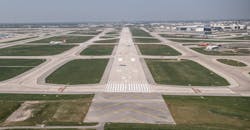2021 Airport Business Project of the Year: A New Runway Takes Off in Chicago
Location: O'Hare International Airport
Project: Runway 9C-27C and Associated Taxiways
Cost: Part of a 2016 $1.27 billion investment
Completion: November 2020
Key Participants: DMJM Aviation Partners, HNTB Corporation, WSP USA, F.H. Paschen and Walsh Construction
The O’Hare Modernization Program (OMP) was initiated by the city of Chicago and the Chicago Department of Aviation in 2002 – and for the past 16 years, Chicago O’Hare International Airport (ORD) has seen continuous work.
“Here at O’Hare, we have been in continuous airfield construction for 16 years, and therefore, we’ve developed expertise on what is needed. It takes coming together with our partners at the FAA and the airlines to deliver on these critical projects,” said Jamie Rhee, commissioner, Chicago Department of Aviation (CDA).
New runways were delivered in 2008, 2013 and 2015, with the penultimate piece – Runway 9C-27C – delivered Nov. 5. Runway 9C-27C is the last new runway in the OMP, which has aimed to reduce delays and increase runway capacity.
“The OMP reconfigured our old antiquated intersectional runway and into a more modern parallel approach for takeoff and landing. It also removed the need for taxing aircraft across active runways, so we were able to basically reduce the amount of traffic that would be going across an active runway at any given time because we now have the parallels,” said Rhee.
Robert Hoxie, chief development officer at CDA, noted the project gives ORD the ability for simultaneous approaches for four parallel arrivals – the first airport with the capability to do so in the U.S.
“We don’t yet have the demand and a compacted 15- or 30-minute period for four simultaneous approaches, but forecast demand is expected to grow and the airfield is now positioned well to handle increased traffic volumes,” added Hoxie.
The runway project has also paved the way for additional terminal building projects at the airport that have been moving ahead throughout the COVID-19 pandemic. The slow down caused by the pandemic allowed ORD to re-phase work and shift focus. Currently, ORD’s Terminal 5 is having 10 new gates added to it.
“We were able to sort of re-phase some of our projects to take advantage of having less activity at Terminal 5, which historically has been our international terminal, but does serve domestic as well,” Rhee said, adding that on Feb. 14, 2020, ORD welcomed Southwest Airlines for the first time in its history.
Runway 9C-27C goes through some of the airport’s oldest sections – ORD’s history dates back to World War II – and the project went through the original airline maintenance facilities that were built when ORD’s became a major passenger airport. This caused support infrastructure – such as fuel lines, major storm and utility lines, aircraft maintenance facilities, firefighting facilities, support buildings for ground equipment maintenance and storage – to be relocated.
“While construction began on the east side of the runway, in the early years, 2016, 2017, 2018, there was considerable effort by both American and United Airlines, which hub here at O’Hare, to build new maintenance facilities, both for their aircraft but also their ground equipment. Together those airlines have about 150 of our 191 gates, but also considerable aircraft maintenance and other support facilities,” Hoxie said.
ORD also worked with fuel companies fuel companies to relocate major fuel mains that connect to storage facilities to the main terminal complex.
“We had to move taxiway infrastructure. We built a deicing facility, so there was a considerable amount of work separate from just the runway that took place in the 2017 to 2020 period,” Hoxie continued.
Being under construction for 16 years brings with it its own set of challenges. Hoxie detailed that the first new runway the city completed was 9L/27R, which is used as an arrival-only runway and required planes to be direct around construction for Runway 9C-27C.
“But the reality is, all the aircraft coming from that runway to their gates in the terminal complex, plus all of the movements that the airlines have of planes from the terminals to their hangers, all had to go through the construction site for 9C-27C,” Hoxie described. “So, the runway actually had to get built in a dozen different little discreet pieces along with the taxiway network that accompanies it, so that we could maintain operations on Runway 9R/27L as well as 9L/27R and all while building in the middle of it while keeping it operational.”
Planning and phasing work to minimize disruptions to the airport’s operations was critical. A construction implementation steering group coordinated with stakeholders in the project during inception and early design phases. When construction began, a working group and a day-to-day coordination forum called Short Term Operation Planning (STOP), met weekly.
“The STOP meeting every Monday morning, you get every contractor that’s responsible for work, FAA, inspectors and FAA navigational aid experts who are delivering their own construction, the air traffic control organization, our own operations and safety and security personnel, the construction manager, everybody comes together to talk about the work for the week,” Hoxie said. “Are we going to do daytime closers for this zone, nighttime closers in this area? Are we going to have a utility change? Are we going to have a configuration change? What do we need to publish for charting cycles?
“It’s a pretty well-orchestrated machine.”
“Making sure that we can run the world’s busiest airfield while delivering the construction is not an easy feat, but these forums have proven to be very, very effective at isolating the needs of construction from the needs of the day-to-day operations.”
In addition to the runway projects, ORD needed to build two new airport traffic control towers in addition to its existing one.
ORD now has towers in the north, south and central parts of the airfield.
One final piece of the OMP remains, the western extension of current Runway 9R/27L, which is under construction and scheduled to be complete on Dec. 2. Once completed, the airport’s 16 straight years of construction will be behind them and ORD will reap the rewards of the long work.
“It’s a complete re-imagination of both the size of O’Hare and the configuration of the airfield. And to think that that was done on an airport that had anywhere from 800,000 to 930,000 annual flights, every single year during that reconfiguration is really a point of pride for the city of Chicago,” said Hoxie.
“It’s really truly once in a generational opportunity to build and enhance our airport from an airfield safety and security and capacity all the way to the terminal buildings,” added Rhee. “Really highlighting the journey from curb to gate and making sure that we do everything that we can to make people want to fly through Chicago, because we certainly think that not only do we fight constantly for that world’s busiest but the world’s best, and we want to be known for that as well.”
About the Author
Walker Jaroch
Editor
Contact: Walker Jaroch
Editor | AMT
+1-920-568-8399
>> To download the AviationPros media kits, visit: Marketing Resource Center
>>Check out our aviation magazines: Ground Support Worldwide | Airport Business | Aircraft Maintenance Technology

